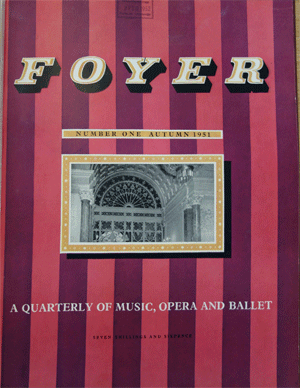Foyer: A Quarterly of Music, Opera and Ballet
Prepared by Richard Kitson
Online only (2020)

Two issues, one in the autumn, the other in the winter of 1951, of Foyer: a Quarterly of Music, Opera and Ballet [FOY] were published by Staples Press Limited at Stratford and London. FOY was produced under an editorial board of notable persons, with Sacheverell Sitwell serving as Chairman and Michael Wood as Managing Editor. The new magazine was brought out shortly after the closing of the Festival of Britain in 1951, owing to the “phenomenal and extraordinary . . . increase in the popularity of both opera and ballet.” The journal’s title was selected as it suggests discussion in a theatre during an interval. The rich content explores historical and contemporary aspects of opera and ballet, by a number of leading writes on these topics, enhanced with many photographs and reproductions of drawings of musical and balletic artists, and associated stage and costume designs and buildings. The issues contain sixty-six and sixty-four pages printed in two-column format. Advertisements, often representing various aspects of the musical and balletic arts, are found at the beginnings and ends of the issues.
In the realm of the contemporary musical world, Sir Steuart Wilson writes about Ralph Vaughan Williams on the occasion of the composer’s eightieth year, with a discussion of his choral works. Dyneley Hussey examines Vaughan Williams’ opera The Pilgrim’s Progress, produced as a contribution to the Festival of Britain. Rafael Kubelik deals with Leos Janacek’s psychological opera Katya Kabanova and his method of illustrating the characters in their music. Hans Heinz Stuckenschmidt reviews both the International Society of Contemporary Music Festival at Frankfurt and the Darmstadt annual Holiday Course in Modern Music. Sacheverell Sitwell gives both an introduction to the instruments of the contemporary clavichord builder Thomas Goff, and presents his own recollections of his first hearings of Russian music. The modernist composer Roberto Gerhard introduces Alban Berg’s Wozzeck, while Imogen Holst provides a summary of the musical and dramatic situations in Benjamin Britten’s Billy Budd. The extension of the operatic repertory through the performance of works of Richard Strauss, Hans Pfitzner and Paul Hindemith, all written before the Second World War, as well as the problematic repertory principle of reviving nineteenth-century operas is explored by Edward Sackville-West. George Frankenstein recounts the history of the Vienna State Opera from the seventeenth century up to the opera house’s destruction by bombing in 1945. Alan Rawsthorne provides a study of the thematic content of Constant Lambert’s ballet Tiresias, while Frederick Goldbeck writes about Lambert’s ballet music and his controversial book Music Ho!
Articles concentrating on historical aspects of music include Joan Haslip’s recounting of the story of the Teatro della Pergola in Florence, built in 1657 and occupied until 1942 by noblemen. Drawings of theatres by the Bibienas family of Bologna are reproduced. Dantan’s woodcut silhouettes of composers include those of Adolphe Adam, Hector Berlioz and Gioacchino Rossini, and those of Italian singers, tenor Gian Battista Rubini, baritone Antonio Tamburini and bass Luigi Lablache. Edward J. Dent studies the century-long performance life of Verdi’s Rigoletto, 1851-1951. A biographical sketch of the castrato singer Carlo Broschi, better-known as Farinelli, is provided with reproductions of fine portraiture. Two reproductions of Alfred Edward Challon’s rare coloured lithographs show soprano Giulia Grisi and bass Luigi Lablache costumed for Bellini’s I Puritani, and Giulia Grisi costumed as Desdemona in Rossini’s Otello.
Of interest to the history of the ballet is a series of extracts from the diary of Margaret Rolfe, a pupil of the famous ballerina and later teacher in London, Marie Taglioni. Arnold L. Haskell discusses the ballets of John Cranko. Svend Kragh-Jacobsen provides an historical sketch of the Royal Danish Ballet. Discussion of Le Carnaval de Venise, a ballet with music by Rudolphe Kreutzer and Louis de Persuis, is enhanced with reproductions of drawings of the dancers by A. E. Chaslin. Irene Lidova studies Serge Lifar, the choreographer. Memories of famed Russian dancer Vaslav Nijinsky are provided buy Lady Juliet Duff. Numerous are photographs of dancers of the Sadler’s Wells Theatre Ballet with biographical sketches by Cyril Beaumont, and discussion by Arnold L. Haskell of the Paris Opéra Ballet. Photographs of sets and costumes for plays and ballets by Christian Bérard are also provided.
This RIPM Index was produced from a copy of the journal held at the Westminster Music Library in London.
